What is Return-To-Work Program?
Return-To-Work is a proactive approach to helping injured workers return to safe and productive work activities as soon as it is physically possible. It is a partnership involving employers, workers, health care providers, unions, and a Return-To-Work committee. The primary goal of a Return-To-Work Program is to return workers to their pre-accident jobs. However, this is not the only goal. A Return-To-Work Program must also strive to restore all injured workers to the economic, social and vocational status that they had prior to the injury.
Generally, Return-To-Work plans, within an overall workplace Return-To-Work Program, are individually designed for each injured worker as a short-term accommodation, working towards a common, primary goal – a successful return to work. Return-To-Work Plans have time frames and schedules that are transitional and depend on the type of injury, physical abilities and limitations, skills, and pre-accident employment duties of the injured worker.
Why Establish a Return-To-Work Program?
Injuries are costly to all members of today’s workplace partnership – employers, workers, medical providers, unions, and the insurance companies. While accident prevention is the best way to reduce overall injury costs, an effective workplace Return-To-Work Program is the best way to manage costs after an injury has occurred. Integral to return to work programming is early assistance in helping workers return to work as soon as it is physically possible. Research and practical experience has shown that for workers who are absent from the workplace:
There is only a 50% chance that they return to work after a six-month absence; This declines to a 25% chance following a one-year absence, and This further reduced to a 1% chance after a two-year absence.
Develop the Scope of the Return-To-Work Program.
To Whom Does the Return-To-Work Program apply? Return-To-Work Programs should be available to all injured workers. Each worker should be treated equally and objectively to minimize conflict and encourage support in the workplace. Fair and consistent treatment of workers help gain and maintain support for the program and maximizes its success.
Formulate Objectives for the Return-To-Work Program
- Objectives should be identified so that the success of the program may be measured and evaluated. Some objectives may include:
- Returning the injured to full pre-injury employment;
- Returning the injured worker to alternate employment;
- Improving employment relations; and
- Reducing the number of workplace accidents.
- Objectives may be added or modified based on workplace’s needs and goals.
Involve and Communicate with the Workforce
Worker involvement is critical for the success of any Return-To-Work Program. The experience and knowledge of people from all areas and all levels of the workplace will provide invaluable information for the development of a Return-To-Work Program. As a first step in developing a Return-To-Work Program, a preliminary meeting should be arranged between the employer and union/worker representatives. This will allow mutual commitment to be gained from the onset. During this initial meeting, discussions should be held around topics such as why to develop a Return-To-Work Program and how to involve the staff in this process.
Following the initial employer/union/worker representative meeting, it will be necessary to inform the entire workforce about the Return-To-Work Program. This can be done best through department and staff meetings, with follow-up details and updates communicated in newsletters, memos, electronic mailings, etc. Some workplaces have also found it useful to designate a centrally located bulletin board to display Return-To-Work Program updates. During workplace program development, there are some consistent messages that need to be shared with all levels of the company – workers, supervisors, managers, union executives and directors. These messages include:
- Human and Financial Impact of Workplace Accidents;
- Responsibilities of the Return-To-Work Partners;
- Benefits of Return-To-Work Programs.
Human and Financial Impact of Workplace Accidents There are many costs associated with the workplace accidents for both the employer and worker. Some costs are direct (those that are easily identified with specific activities) and others are indirect (those that are not identified with specific activities). The following list provides some examples of each:
- Direct Costs include:
- Health care expenses;
- Assessment care expenses;
- Accident site clean up;
- Decreased net income for injured workers;
- Damage to materials, building, tools and equipment;
- Fines;
- Workers’ Compensation benefits
Most of the expense of workplace accidents consist of indirect or hidden costs. They include:
- Injured workers’ lost productivity;
- Lost productively of co-workers attending to the injured worker or undertaking his/her workload temporarily;
- Hiring and training of replacement workers;
- Replacement of equipment and tools;
- Replacement of first aid supplies;
- Transportation of damaged equipment for repair;
- Investigation of the accident;
- Possible legal expenses;
- Decreased productivity of co-workers due to low morals;
- Paperwork;
- Overtime to make up for lost productivity;
- Lost productivity as injured workers attend health care appointments.
The above costs are ones to which a dollar value can be assigned. But what about the intangible costs to the worker? What dollar value can be assigned to these?
- Pain;
- Suffering;
- Reduced health;
- Altered social life;
- Changed family life;
- Reduced quality of life;
- Loss of security;
- Decreased self esteem;
- Loss of productivity and ability to earn an income;
- Increased stress.
The best way to reduce and perhaps eliminate all these costs is to prevent the accident from happening in the first place. The establishment of a Safety Program at the workplace can help achieve this. However, when an injury does occur, costs can be minimized by having a Return-To-Work Program in place that will assist in restoring the injured worker to a healthy and full lifestyle, both on and off the job.

